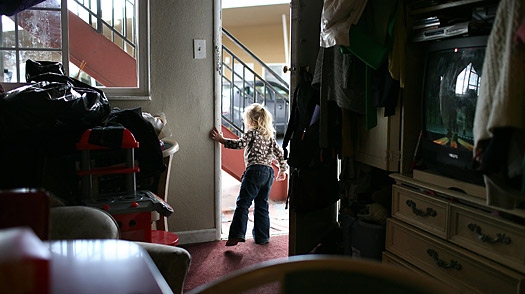
Even before the financial and home foreclosure crisis hit full stride, the number of homeless children in America had reached an alarming level. The National Center on Family Homelessness released a report today that estimates that one in every 50 American children was homeless between 2005 and 2006. That totals roughly 1.5 million kids. While the center provided no previous statistic to compare against that figure, a study conducted with different measures published in 2000 put the total at 1.35 million children living in homelessness each year. The numbers are likely to get worse as the economy continues to decline. “We know the numbers are going to skyrocket,” says Ellen Bassuk, president of the Newton, Mass.-based Center and an associate professor of psychiatry at the Harvard Medical School.
Indeed, a quick survey of the country provides lots of evidence to support those fears. Chicago public school officials report the number of its 405,000 students deemed homeless soared to 11,143 last month from 9,182 in February 2006. School officials in Hillsborough County, Fla., which includes Tampa, have so far counted some 1,700 homeless students — and expect the figure to eclipse last year’s 2,020. Meanwhile, the surge in homeless families has overwhelmed Massachusetts’ shelters, forcing state officials to book motel rooms for the displaced. In January, some 4,600 homeless children were reported in the state’s shelters and motels, up from 3,411 from roughly one year earlier.
According to the new report, the states with the highest number of homeless children in the period studied were Texas , California , Louisiana , Georgia and Florida . The states reporting the smallest populations of homeless children: Wyoming , Rhode Island , Vermont , North Dakota , and South Dakota . However, the report also ranks the states according to parameters that go beyond their share of homeless children, factoring in, among other things, incidence of such health conditions as asthma and tooth decay. With that framework, Connecticut, New Hampshire, Hawaii, Rhode Island and North Dakota were rated among states that dealt best with the problem overall. At the bottom of the list: Texas, Georgia, Arkansas, New Mexico and Louisiana.
Families with children comprise roughly one-third of the nation’s homeless population. Poverty continues to be a core reason for the crisis, though the aftermath of Hurrican Katrina combined to swell the numbers in Louisiana, Texas and Georgia. Since the 1980s, single mothers have accounted for an increasing share of the homeless population, partly because of increased divorced rates, gender and wage disparities, and the shrinking supply of affordable housing. Officials believe that the current home foreclosure crisis will be adding a new demographic to these statistics: middle-class blacks and Latinos. “It’s families that were living pretty independently, doing pretty well. And, through just one event, it was, like, a domino effect — if one part of the puzzle breaks off, then everything breaks off,” says Michael Levine, who coordinates social work programs for Hillsborough, Fla.’s 206,000-student school system.